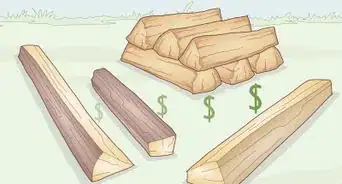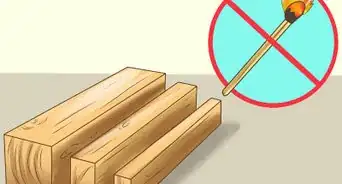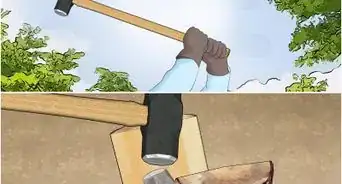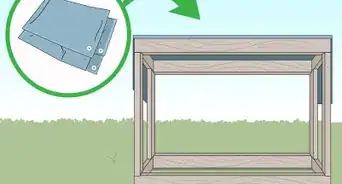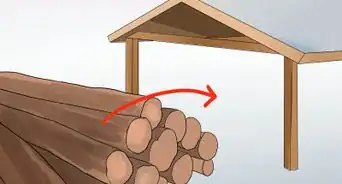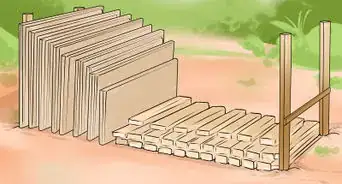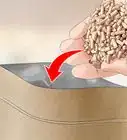wikiHow is a “wiki,” similar to Wikipedia, which means that many of our articles are co-written by multiple authors. To create this article, 9 people, some anonymous, worked to edit and improve it over time.
wikiHow marks an article as reader-approved once it receives enough positive feedback. This article received 16 testimonials and 91% of readers who voted found it helpful, earning it our reader-approved status.
This article has been viewed 418,700 times.
Learn more...
One of the most useful tools for cutting firewood is a good "X" shaped sawbuck.
A sawbuck is a special kind of sawhorse framed for holding rough wood so you can saw it into lengths suitable for use in a stove or fireplace.
The sawbuck basically consists of two "X" forms -- one at each end -- which may be stabilized by a third (central) "X". The long firewood to be cut is placed in the top ("V") part of the "X" pieces where it may then be sawed.
Steps
-
1Select the size. Design the permanent sawbuck to be 6 vertical 2x4's (38 mm x 89 mm) or 2x6s (38 mm x 140mm) of about 4 feet (1.22 meters) long and 4 horizontal 2x6's 5 feet (1.52 meters) long using 3.5 inch (8.89 cm) wood screws or nails.[1] (See "Tips" for information on making a demo/prototype version instead.)
- Cutting the top "V" form portion at an angle and with a shorter top would make it lighter and more open. Adding a trough or floor, as a retainer like feature, into the top "V" allows for a lower chance of shorter pieces of firewood unexpectedly falling from the inner part of the sawbuck to the ground.
-
2Place the middle of the "X" a little higher for use with a chainsaw; rather than lower for a bow saw(if you prefer).Advertisement
-
3Design your sawbuck/sawhorse by considering various methods shown in the illustrations. Tailor the design as you desire or require.
-
4Use suitable boards for your project. Nominal 2X6s or 2X4s of pine (southern yellow or lodgepole or white), or spruce will be fine.
-
5Consider starting with one (the first) "X" temporarily attached together with two nails/screws to see how tall and wide that you want to make it.
- Take it apart and angle-cut and trim the angle of the "V" as shown in the photo above.[4] Angled cutting of the "V" and making the upper "arms" shorter than the "legs" will make it less top-heavy. The arms help to hold poles and limbs to be cut on the sawbuck.
-
6Use this as your pattern for the rest.
- Feature: the upper "V" part being deep allows you to nestle and cut two or more narrow poles or tree limbs (around 3 to 8 feet (91.44 cm x 44 meters) in length) for cutting with a chainsaw to chop your firewood at a faster rate.
-
7Design a lower sawbuck if you would like to use the "X" sawbuck with a hand "bow-saw". Make the sawbuck about only 20-24" (50.8 cm x 60.9 cm) high to the center. This will allow the user to put a foot on top of the poles or resulting in the split wood being cut when it is that low (as illustrated).
-
8Design a wide, heavily braced base to give you more stability while handling a chainsaw.
- Caution: A lightweight sawbuck might lead to an injury if it falls over while you are cutting. Don't use a smaller sawbuck for chainsaw work.
-
9To build a non-folding sawbuck, simply connect the "X" forms together, using 4 to 6 nails/screws driven permanently into the near-center of each "X".
Folding Sawbuck
-
1Make the sawbuck fold if you like. One way to connect the sawbuck together is to use one big bolt of about a 4 inch (10.16 cm) long, and 1/2 inch (12.7 mm) in diameter.[5]
- You may find inexpensive [or free] long bolts, and nuts that fit them, on the ground in a self-service, automobile wrecking yard). Put it in the exact same placement at the center of each "X", using extra-large washers, so that it can be clamped together and loosened to fold for storage.
-
2Consider screwing on a leg spacer-brace on each "X". Then unscrew the end spacer-brace to allow the "X" to fold.
- Long, common bolts are not very expensive- they cost between $1 to $1.50 each at a lumber or hardware store. (But, tempered, hardened, fine threaded bolts cost about 4 to 5 times as much.)
Rustic Method
-
1A simple rough sawbuck or sawhorse may be built in the woods for a camp or lodge.
-
2The rustic form shown here can be made in the field from available materials, following a similar process but with wooden poles instead.
- State parks and such probably do not allow any harvesting of wood, so this - building a sawbuck- is for private land or the untamed wilderness.
Community Q&A
-
QuestionIf a sawbuck has 3 x's, is the distance between them the same, or is one section of the x narrower?
 Community AnswerYou would want one space smaller for those final cuts. Consider spacing based upon how long you want each length of your firewood to be.
Community AnswerYou would want one space smaller for those final cuts. Consider spacing based upon how long you want each length of your firewood to be. -
QuestionHow are the posts held together?
 Community AnswerBolts in the main frame and nails in the rest looks and works wonderfully.
Community AnswerBolts in the main frame and nails in the rest looks and works wonderfully. -
QuestionHow about one for bigger, heavier logs that fell in the yard? I need to get one end off ground a tad to cut, but it's really heavy?
 Upnorth HereTop AnswererOne of the best hand tools for lifting a log off the ground for bucking is a "timberjack", which is a peavey lever with a 90-degree foot near the swinging hook. You jam the peavey into the ground next to the log and catch the log with the swing hook, pulling it toward you, to have it end up resting on the fixed leg, held by the swing hook. You may also simply pound a wedge under the end you want to lift, or use a peavey to lift one end and slide a block under it.
Upnorth HereTop AnswererOne of the best hand tools for lifting a log off the ground for bucking is a "timberjack", which is a peavey lever with a 90-degree foot near the swinging hook. You jam the peavey into the ground next to the log and catch the log with the swing hook, pulling it toward you, to have it end up resting on the fixed leg, held by the swing hook. You may also simply pound a wedge under the end you want to lift, or use a peavey to lift one end and slide a block under it.
Warnings
- Avoid tipping the sawbuck over due to chainsaw kickback while cutting - the base should be built heavily enough to be stable.⧼thumbs_response⧽
- Ordinary head, hearing and eye protection should be adequate protection or as recommended by equipment manufactures when sawing lumber, poles, limbs and/or driving nails.⧼thumbs_response⧽
Things You'll Need
- Soft rubber, tissue or cotton ear plugs,
- Simple hat or hardhat,
- Safety glasses,
- Circular saw or handsaw, tape measure, square;
-
Hammer
- Zinc-galvanized nails, 3.5 inch (approx);
-
Or: Electric drill
- Zinc-galvanized screws, 3.5 inch long;
- Lumber of the type you prefer
References
- ↑ https://survivalsherpa.wordpress.com/2013/11/06/building-a-sawbuck-work-smarter-in-the-woodpile/
- ↑ https://survivalsherpa.wordpress.com/2013/11/06/building-a-sawbuck-work-smarter-in-the-woodpile/
- ↑ http://howtospecialist.com/workshop/how-to-build-a-folding-sawbuck/
- ↑ https://www.firewood-for-life.com/sawbuck-plans.html
- ↑ https://www.firewood-for-life.com/sawbuck-plans.html
